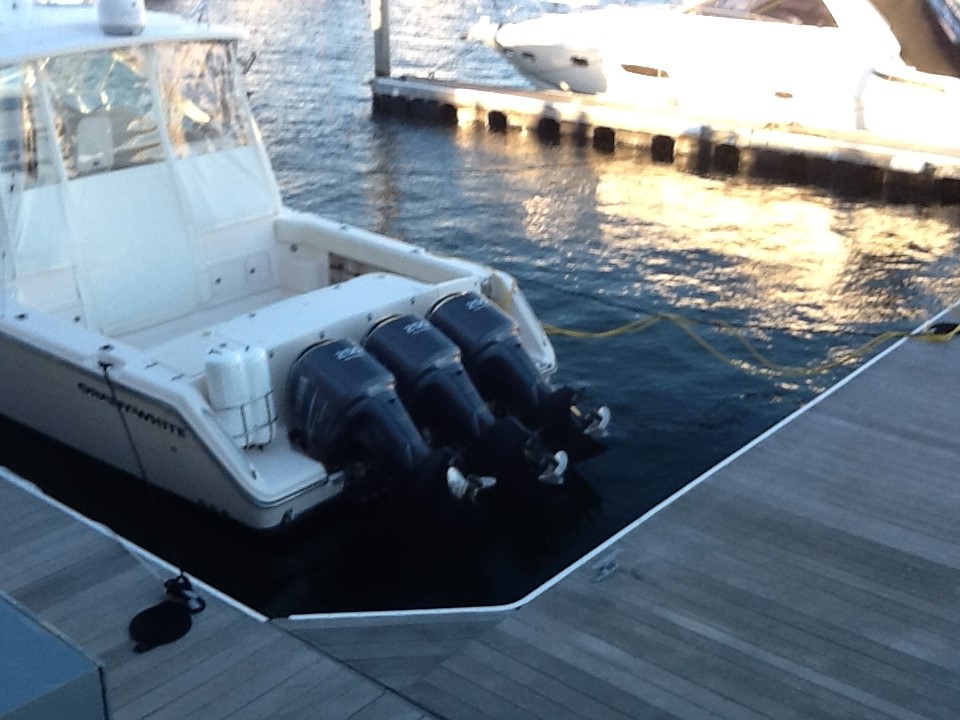
by Rick O'Connor | Aug 14, 2015

Boating is a very popular activity in the sunshine state.
Photo: Rick O’Connor
Okay… Let’s start at the beginning. We began drilling oil over 100 years ago. The crude was refined into kerosene, gasoline, plastics, and other products that have completely changed our lives. A huge international industry developed from the drilling and employed who knows how many people. But then a few problems began to emerge…
The emissions from burning oil have added compounds to our atmosphere that have contributed to human health issues and have changed the climate. As the human population grew the demand for this energy source grew, and the problems grew as well. One of the first steps made by the governments and the industry to curb the problems was the removal of lead from gasoline. At first this was problematic because many of the internal combustion engines that ran on gasoline did not run efficiently on unleaded and a back-lash occurred. Service stations offered both leaded and unleaded at the pump and motorist could choose. The car industry followed by developing engines that ran on unleaded only and eventually leaded gasoline was no longer offered. Since the phase out the blood lead level has dropped from 88% of children in the United States to 1% in 2006 (www.worstpolluted.org).
The next issue was the amount of oil. Though many text list fossil fuels as a renewable energy, it takes millions of years to renew it – so in the time frame we think of it is basically a non-renewable resource. With a finite amount of oil available the industry began looking for new sources of oil and encouraging the public to conserve their use. The government answered this by requiring the car industry to produce fuel efficient automobiles, which they have. My original truck got between 8-12 mpg, today’s trucks can get over 20 mpg. Smaller, more efficient engines that burn unleaded gasoline have certainly improved some of the problems.

One of many marinas in Florida where boats fuel.
Photo: Rick O’Connor
However the population continues to grow. I remember just a few years ago everyone was amazed when we hit 6 billion humans, we are now at 7.2 billion and the clock moves quickly (http://www.census.gov/popclock/) . The largest growth has been in China and India. Both of these nations have experienced huge increases in their economy and quality of life. As their economic status improved their demand for energy increased and concerns about the amount oil demand increased. With the somewhat finite amount of oil, and the compounds that are still part of the emissions. Many became concerned about what would happen with growth in that part of the world. One answer to both emissions and amount was to begin searching for alternative fuels. Biofuels was one option. These fuels can be generated from plant material, which can produce ethanol. There are certainly some problems with growing corn for fuel instead of food but this is one option that the industry began to explore. Just as the original engines had problems with unleaded fuel, today’s engines have problems with ethanol. The engines that power the Indy and Formula 1 race cars do use biofuels but who can afford a Formula 1 engine? The industry’s response was to blend ethanol into the existing unleaded gasoline and offer this. The hope was that the global amount of gasoline could be conserved using this method. The original fuel was 10% ethanol and was called E-10 fuel. As expected problems occurred. Though the engine ran pretty efficiently if the fuel was used in a relatively quick period of time, and not allowed to sit within the tank and fuel lines, the ethanol began to degrade parts. Pieces of rubber and plastic blocked fuel lines causing all sorts of problems. I personally experienced this issue with my outboard motor. The outboard industry responded by developing more E-10 friendly engines and additives you can use if your fuel will be sitting in the tank for long periods of time. It is currently recommended that if you are not going to use your lawnmower or outboard over winter that you fill the tank for storage. Ethanol breaks down and water is produced. With a full tank there will be less water accumulation over time. Now comes E-15.
Yep… E-15, 15% ethanol. Though this move will eventually improve some of the problems with using oil there will be, as there have been, some growing pains. IT IS NOT RECOMMENDED THAT OUTBOARD MOTORS, LAWN CARE MOTORS, OR ANY OTHER SMALL ENGINE, use this E-15 fuel. It is currently being offered at service stations but in many cases is NOT clearly marked. All boaters, lawn care operators, and anyone else who uses small engines should check the gas pump labels carefully before fueling.
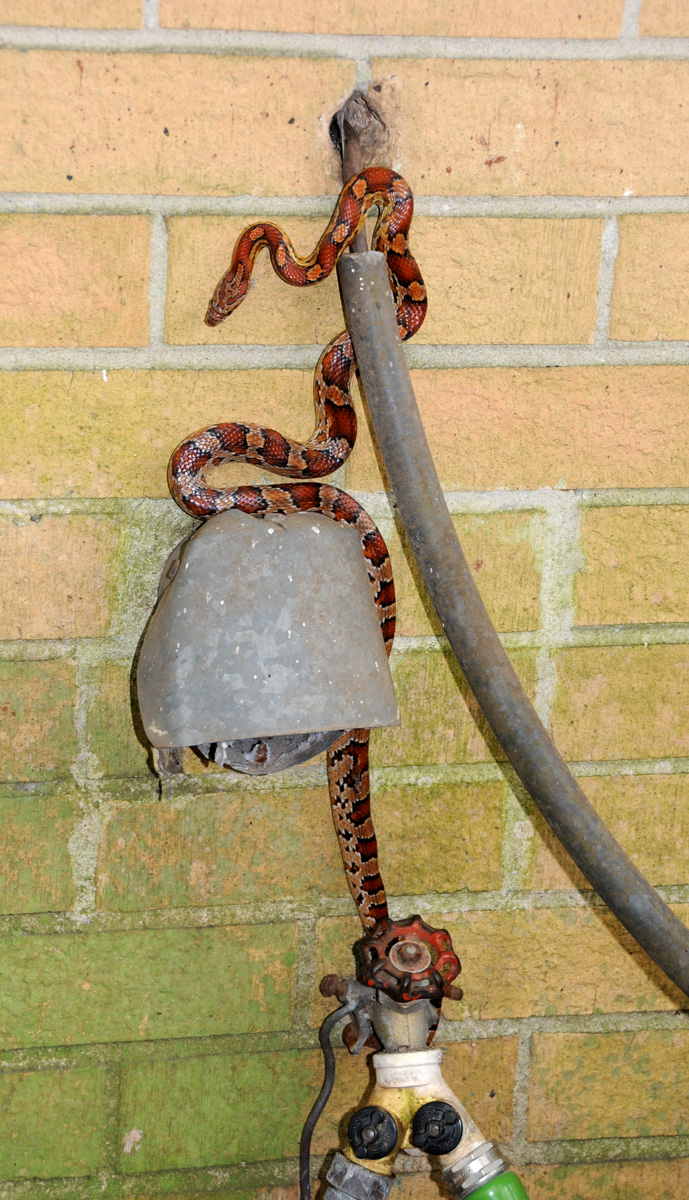
by Rick O'Connor | Aug 14, 2015
Most people, including myself, have been taught this. Snakes are in an unusual situation of trying to kill prey with no hands or claws. A few can inject venom, others either swallow it whole (such as an egg) or the coil around their prey “suffocating” it – or so we thought. It has been my understanding that snakes did not actually “squeeze” the air out of their prey but rather coil tighter each time the prey exhales, tighten the coils until the prey is dead due to lack of oxygen. A recent paper published in the Journal of Experimental Biology is challenging this.
The issue stems around the fact of how fast the prey die. Some biologists felt death of the prey occurred to quickly for suffocation; thus began the hunt of what was the cause. Dr. Scott Boback, of Dickinson College in Pennsylvania, looked at the possibility of cardiac arrest. He and his team developed a method of monitoring cardiac and circulatory data in rats before, during, and after an attack by a constricting snake; in this study – the common boa. Using pre-attack vitals as baseline the team compared numbers during the attack and after death; which occurred, on average, 6.5 minutes. What they found was interesting.

A constricting gray rat snake coils around a bird.
Photo: Nick Baldwin
Within six seconds of being bitten and having the body coil the peripheral arterial blood pressure dropped by half and the central venous blood pressure increased six fold. After 60 seconds the heart rate had dropped by 50%. After death, again mean time was 6.5 minutes, the peripheral arterial blood pressure and heart rate had dropped significantly and 91% of the rats (n=11) had evidence of a dysfunctional cardiac system. Blood samples were taken from the deceased rats. These samples indicated that the potassium levels had increased 2-fold and the pH and dropped from 7.4 to 7.0. Some suggest that the increased potassium levels may have been toxic enough to kill the rat.
Though this is only one study the results do suggest that the cause of death may be due to cardiac arrest and not the lack of oxygen. For many of us it is a point of “who cares… the rat is dead”. But for those of us in science education (teachers, park rangers, etc.) the results are of interest. We are being asked to explain how the scientific process works to students, visitors to parks, and to the general public. This is a good example of how science works. The process of experimentation finding results that do not always fit the “norm” of general understanding yet they do occur, generating more questions and more experimentation. Though this one study does not mean that suffocation is incorrect it does suggest there is another explanation and this, at least at this stage, is how we should explain such things to the public.
To view a copy of the article and abstract for this paper visit:
file:///C:/Users/roc1/Documents/Wildlife/nusiance%20species/Snakes/Living%20With%20Snakes/Snake%20constriction%20rapidly%20induces%20circulatory%20arrest%20in%20rats.html
http://jeb.biologists.org/content/218/14/2279.abstract
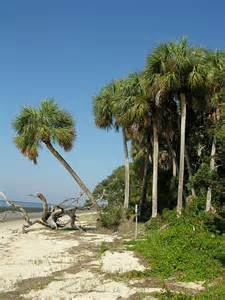
by Rick O'Connor | Aug 7, 2015
First let me explain that Seahorse Key is not in the Florida Panhandle but the story is interesting and a similar phenomena could occur here. Seahorse Key is an isolated island 3.6 miles southwest of Cedar Key in Florida’s Big Bend. There is a science lab owned and maintained by the University of Florida and Captain Kenny McCain on the island but can only reached by boat. Many forms of wildlife, particularly birds, seek out these isolate islands for nesting due to the lack of predators; and Seahorse Key is no exception. Another interesting point about this island is that it may have the highest density of cottonmouths in the state. Dr. Coleman Sheehy has been studying this population and estimates that there may be about 600 cottonmouths on the island. So what is the mystery?
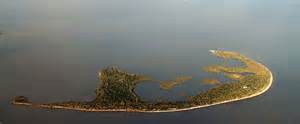
Seahorse Key. An isolated island near Cedar Key
Photo: FMSEA
Well we will first look back to last year and the nesting habits of the island’s birds. In 2014 Vic Doig of the U.S. Fish and Wildlife Service had logged seven different species of egrets, herons, cormorants, pelicans, and ibis nesting on the island. The number of nest per species varied from 100 to 5,000 with the white ibis producing the highest number. Dr. Sheehy surveys the cottonmouths by walking the shoreline and counting the number of snakes he encounters; which is typically around 30. The snakes and nesting birds are concentrated near Gardiners Point. Though the cottonmouths feed on rats they seem to rely on the fish that fall from the nests above.
As 2015 began the biologists noticed something different right off the bat. Though the birds were returning they were not returning in typical numbers, particularly the white ibis. These birds normally are the most abundant nesters on the island, but not this year. Dr. Peter Frederick, University of Florida’s Department of Wildlife Ecology and Conservation, did not seemed to alarmed by this knowing that white ibis are nomadic and do not stick with the same nesting locations for more than a few years. They tend to go where the food is most abundant. No mystery here… Then it happened…

A cottonmouth consuming a fish from a birds nest.
Photo: University of Florida
Within a very short period of time, during the second week of April, all of the other birds began to leave. Researchers found the nests falling apart, no eggs or chicks within them, and hundreds of eggs on the ground. They also found the remains of 26 dead birds in the area. Where had they gone? What had happen?
Autopsied birds found no consistent cause of death. Most of the eggs on the ground had small holes indicating they were preyed upon by birds, most probably fish crows. However these birds are more opportunistic scavengers and would have fed on the eggs only after they had fallen from the nests. Researchers then discovered that many of the birds had relocated to nearby Snake Key. Though they had begun nesting there, fewer than half had done so. All seven species were found there but the number of nests had dropped from 100 – 5,000 to 50 – 600. Many of the birds were still missing. Where did they go? Better yet, why was Snake Key selected and Seahorse abandoned? And did the exodus of birds from Seahorse impact the snakes? The answer is… Yes. Dr. Sheehy’s survey found that the number of snakes encountered along the forest edge had dropped from 30 to 10. He noticed these snakes were thinner and he observed one cottonmouth consuming another, something he had not noticed before. The snakes had been impacted by the decline in nesting birds. What had happened on Seahorse Key?
One idea was put forth by Dr. Sheehy. He had noticed an increase in the number of raccoons on the island. Again, these isolated islands are selected for by nesting birds because of the lack of such predators and Dr. Harvey Lillywhite indicated that the typical number of raccoons on the island is zero. But Dr. Sheehy and Captain McCain had trapped and relocated seven raccoons earlier this summer. This suggests that a large group (large for this island) had found their way to Seahorse Key. Dr. Sheehy suggests that the cause of the movement of birds were the raccoons. There is no evidence of them attacking the birds but they believe the shear presence of the animals was enough for the birds to relocate. However Dr. Fredrick points out that (a) there was little evidence of the raccoons preying on the fallen eggs and (b) he could not find track or scat evidence of more than one or two raccoons on the island during his initial survey after the birds left. He is not so sure the raccoons were the cause.
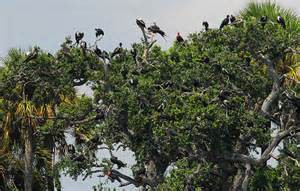
Nesting birds on Seahorse Key
Photo: courtesy of flickr
Then there is the question… Where did the seven raccoons trapped come from? One suggestion was that they were released by locals. This was based on the fact that raccoons captured were well fed and had a mild temperament, not what you typically encounter with trapped raccoons from the wild. Later there was a confirmed report of a local who does take in orphaned raccoons, raises them, and releases them; they could have released some on Seahorse Key – but this has not been confirmed.
So right now this mystery remains unsolved. But the story does indicate the types of problems that can occur when humans relocate animals to habitats they do not typically live in. It takes years for Mother Nature to develop a balance only to have it quickly fall apart by the human release of animals we wish to move or that we think will do better in another location.
You can read more on this story at:
http://fieldguide.blogs.gainesville.com/427/amysteryatseahorsekey/
http://fieldguide.blogs.gainesville.com/450/a-mystery-at-seahorse-key-part-2/
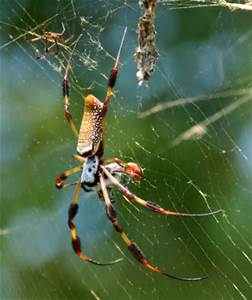
by Rick O'Connor | Aug 7, 2015

The elongated body of the Golden Orb Weaver. Photo: Molly O’Connor
TELL ME NO! Please tell me these huge spiders are not a part of our summer. People are afraid snakes… that’s a given – but there are just as many afraid of spiders. Honestly, after years of leading field hikes into the north Florida environment, when we encounter a spider web on the trail I have heard more screams from the boys than from the girls. But most are afraid and there nothing is more terrorizing than the huge, almost hand-size, Golden Orb Weaver (or banana spider).
The Golden Orb Weaver is one of 180 species of orb weavers from around the world; one from Australia is large enough to feed on small birds. The local species is Nephila clavipes and is found throughout the southeastern United States; in the warmer months it may reach as far north as New England. Female Orb Weavers are the really big ones you find on the webs. Their body lengths can reach 2” (not including the extended legs) and the males are much smaller at 0.02”. They have long inward pointing legs with hair-like tuffs at the joints. These are very useful in web building. They have the typical “red/yellow/black” coloration of a venomous animal and their mimics; but N. clavipes is no mimic… though mild, they do have venom. There is another orb weaver spider that is large a constructs large webs. This is the Black and Yellow Argiope (Agriope aurantia). One way to distinguish this spider from the Golden Orb is the “zig-zag” pattern it adds to its’ web near the center (where the spider spends a lot of its time).
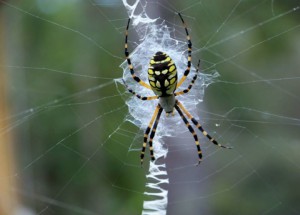
The zig-zag pattern of the Black and Yellow Argiope spider helps to distinguish from the Golden Orb. Photo: Molly O’Connor
The name “Golden Orb” does not come from their body coloration but from the color of the silk produced for their webs. It is believed that the yellow/golden color of this silk makes it difficult for others to see in open sunny areas. Many hikers can attest to this… they are hard to see, until you become entangled… then become aware the large spider is very close and heading your way… then the scream. N. clavipes can actually adjust the hue of yellow in the silk to match the sunlight conditions where it is building its web. It is amazing to see how quickly they replace their large webs, over 3 feet in diameter, after they have been removed by people. Actually they mend and move their webs regularly. They tend to build them off ground, at eye level to the tree tops, in open areas near a line of trees. I have actually seen one build the web across a dirt road between two stands of pines as if it were going to try and capture a truck! Though species of Orb Weavers feed on small birds and snakes, N. clavipes prefers flying insects. They do not wrap their prey in silk for later feeding, as many spiders do, but rather consume them almost immediately. This may be because of a small slivery spider called Argyrodes. This spider feeds on the captured food of other spiders. N. clavipes feeding may be an adaptation to combat this kleptoparasitic spider. Another interesting behavior I have noticed is when the heavy rains come. I have noticed the web remains but the spiders leave. I am not sure where they go, most likely a hiding spot nearby, but they do leave.
The fear of spiders is most likely similar to the fear of snakes… they are venomous. Venom is used to kill prey and many times is not strong enough to kill humans, but the fact that some species can kill makes folks a bit nervous. Despite local tales that say otherwise, the venom of N. clavipes is mild. It is a neurotoxin, which can be potent, but the bite from this spider is not lethal. The typical response is pain and redness at the site of the bite, blisters may form, but it is actually less potent than a bee sting.
Like many other species of spiders, the Golden Orb Weaver is a beneficial backyard creature consuming hundreds of biting (in some cases disease carrying) insects. The large webs can be a nuisance around backyard patios and swimming pools but they can easily be moved to other locations with a rake or broom. We have many of them in our yard, one out of my office window, and enjoy watching them work. They are good panhandle neighbors.
For more information on these beneficial creatures visit:
http://okeechobee.ifas.ufl.edu/News%20columns/Orbweaver.spiders.htm
http://edis.ifas.ufl.edu/in017
http://edis.ifas.ufl.edu/in467

by Rick O'Connor | Jul 31, 2015
For locals along the coast ghost crabs are as common as mockingbirds and mourning doves. Before Ivan, when the dunes were larger and closer to the road, viewing the white crabs scouring across the road at night in your headlights forced all into defensive driving maneuvers. And for those who have ever tried to catch one, all would agree it is one of the fastest animals on the beach.

The common ghost crab. Photo: Virginia Institute of Marine Sciences
Ghost crabs (Ocypode quadrata) are members of the fiddler crab family. Like their fiddler crab cousins, they are more terrestrial than aquatic and dig burrows to protect themselves from predators and the intense heat of the midday sun. Though ghost crabs can be found in a variety of locations on the island, they are most frequently found between the mean high tide line and the upper portions of the primary dune line; typically on the Gulf side. Their “J” shaped burrows reach the water level below the sand and can run as deep as four feet. Larger individuals can dig deeper burrows and are often found further away from the water’s edge. These are crabs and thus still possess gills. Gills must be in contact with water in order to obtain needed oxygen. To do this ghost crabs have a gill chamber that will hold water for periods of time. The crabs can obtain water either at the bottom of their burrow or by running to the edge of the Gulf. And running is a good term for what they do. Once they have left the burrow they will lift five of their 10 legs above their head running on the remaining five. Running sideways they will have three in contact with ground in the direction they are going and two on the opposite side; if you look closely you can actually the remaining legs raised high in the air. When they tire, they will stop, make a 180° turn, and begin running again; resting their legs. They have reached speeds of 1.6 meters/second, which is 3.5 mph!
Ghost crabs are most active at night, though they are found at dawn and dusk and occasionally at midday. They feed on invertebrates at the surface zone such as mole crabs (sand fleas) and coquinas (bean clams). Dead fish and other animals found along the shoreline are also part of their diet, often dragging them back to their burrow. Unfortunately they are one of the predators of sea turtle hatchlings heading to the Gulf at night. Ghost crabs breed in late spring and early fall. The females will carry her developed eggs to the surf zone to release them. The developing young will return the following spring to mate and release their own eggs. Females may produce eggs in their second year but rarely live to do the same the third year. They are quite social with other crabs communicating, like their fiddler crab cousins, with body postures and claw movements. They are most active from March to December, plugging the entrance of their burrows and going dormant during the colder months of the year.
There has been concern about the impact of the oil spill on their numbers and the numbers of their prey, mole crabs and coquina. Our beaches did have small and large patches of oil that seeped down into the sand and then there were the methods used to remove the oil from the beach. At this point we do not know how hard their populations were impacted but scientists have collected data before and after the spill and are analyzing this now. However low their population dropped I am sure these resilient creatures will rebound and we will once again dodge them during our evening drives.














